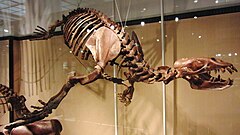Allodesmus
| Allodesmus Temporal range:
| |
|---|---|

| |
| Allodesmus skull | |
| Scientific classification | |
| Domain: | Eukaryota |
| Kingdom: | Animalia |
| Phylum: | Chordata |
| Class: | Mammalia |
| Order: | Carnivora |
| Clade: | Pinnipedia |
| Family: | †Desmatophocidae |
| Genus: | †Allodesmus Kellogg, 1922 |
| Species | |
| |
Allodesmus is an extinct genus of pinniped from the middle to late Miocene of California and Japan that belongs to the extinct pinniped family Desmatophocidae.
Description and biology
Allodesmus measured about 8 feet (2.4 m) long and weighed 800 pounds (360 kg). Allodesmus had the specific anatomical features found in modern polygynous pinnipeds: sexual dimorphism, strong canines for fights between bulls and teeth with well-defined growth zones, a result from periodic fasting (in order to defend their harem, males would not take to the sea to feed during the breeding season).[1]
Taxonomy

Allodesmus sinanoensis and A. packardi were previously assigned separate genera, Megagomphos and Brachyallodesmus, respectively, but many authors questioned this generic distinction, and the cladistic analysis by Boessenecker and Churchill (2018) found no support for this generic scheme. Atopotarus, referred to Allodesmus by some authors (e.g. Mitchell 1966), is distinct from Allodesmus by the absence of a prenarial shelf and M2, double-rooted cheek teeth, a small, triangular postorbital process, and a mastoid process projecting ventral to the postglenoid process.[2][3]
References
- ^ Bonner, Nigel (1982). Seals And Man - A Study Of Interactions. USA: University of Washington. pp. 11. ISBN 0-295-95890-1.
- ^ L. G. Barnes and K. Hirota. 1995. Miocene pinnipeds of the otariid subfamily Allodesminae in the North Pacific Ocean: Systematics and relationships. The Island Arc 3:329-360
- ^ Robert W. Boessenecker; Morgan Churchill (2018). "The last of the desmatophocid seals: a new species of Allodesmus from the upper Miocene of Washington, USA, and a revision of the taxonomy of Desmatophocidae". Zoological Journal of the Linnean Society. Online edition. doi:10.1093/zoolinnean/zlx098.
- Encyclopedia of Marine Mammals, ed. William F. Perrin, Bernd Würsig, J.G.M. Thewissen
External links




